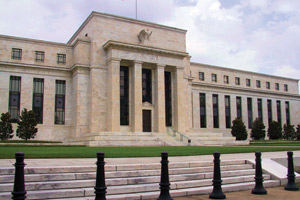
Photo of the Federal Reserve used under a <a href="http://en.wikipedia.org/wiki/File:Federal_Reserve.jpg" target="blank">Creative Commons</a> license.
After weeks of suspense, the Federal Reserve revealed the results of its bank stress tests Thursday—as if they actually meant something. The Fed claimed to have conducted a rigorous investigation of the nation’s 19 biggest banks to determine which ones would need more capital in the event of further economic woes, like a spike in unemployment or a dip in home prices or GDP. And according to Fed chairman Ben Bernanke, we should take “considerable comfort” in the results. But don’t be fooled by the drama: All the stress tests did is hand the banks a free pass for further federal aid.
The tests were a meaningless exercise in numerous ways. For starters, the results were predictable—the 10 banks that need more capital were obviously still struggling. Nor was there a big mystery about how much capital they required: There are rules that determine the amount of money banks should set aside to cover their risks, and had those rules been enforced, the institutions wouldn’t now be dependent on the public dime. What makes the hype over the stress tests so galling is that the Fed should have been doing this kind of monitoring all along.
But the most farcical thing about the process is that after more than two months of intrigue and secrecy and tactical leaks, we still don’t have an accurate picture of the weaknesses of the financial system. In fact, the banks were allowed to participate in the design of the tests—for instance, by naming the price of the securities that they can’t get rid of. Now, the government is using the results as rubber stamps for the flawed policy it has pursued since the crisis started.
Before the stress tests, banks received trillions of dollars through various federal channels. Now, well, we have tests to confirm that we should keep doing the same thing. Bernanke said as much to Congress on Tuesday: “Bank holding companies will be required to develop comprehensive capital plans for establishing the required buffers…with the assurance that equity capital from the Treasury under the Capital Assistance Program will be available as needed.” Translation: Banks get to choose how to find more capital. And if they fail to raise enough funds, the government will keep dumping money into mismanaged firms, in the hope that it will one day trickle down to the little people.
The banks that came up short in the stress-test sweepstakes have seen the biggest drops in their stock prices—and thus lost the most taxpayer money—since they got their first TARP injections last October. (This list includes Citigroup, Bank of America, Wells Fargo, PNC Financial Services Group, SunTrust Banks, Fifth Third Bancorp, and Regions Financial Corp.) If the TARP infusions plus the trillions in cheap loans provided by the Fed haven’t worked, another round of new capital probably won’t either.
Finally, despite Treasury Secretary Tim Geithner’s declaration that the results are “reassuring,” the banks are likely in worse shape than the tests suggest. Just because a bank avoided the capital penalty box doesn’t mean it’s healthy. Some, like Goldman Sachs, are investment banks that converted to bank holding companies last fall in order to access federal money, and received a two-year grace period to standardize their books with other banks. And some happen to enjoy a symbiotic relationship with the Fed, like JPMorgan Chase, whose last two takeovers (of Bear Stearns and Washington Mutual) were government-funded. JPMorgan Chase’s stock was one of the biggest losers after TARP began, yet its tests indicated that it has somehow taken care of its capital needs just fine.
Those banks that were ordered by the Fed to come up with more capital may also be shakier than Geithner would have us believe. The two biggest problem banks, Citigroup and Bank of America, spent last week frantically trying to persuade the Fed that they didn’t need extra capital, although they both posted significant increases in losses from loans in their most recent quarterly results. Bank of America’s CEO Ken Lewis insisted, “We absolutely don’t think we need additional capital.” Guess what? His bank needs $33.9 billion, according to the government. The glaring mismatch between the banks’ rosy public statements and the Fed’s (gentle) testing suggests a troubling reluctance to face hard facts about the real condition of the banking system. Too many numbers are open to interpretation and debate, which usually means that things are worse than they seem.
It’s time for the truth from the Fed, or the Treasury, or the White House. We need a different approach that provides capital directly to consumer loans, in order to loosen up credit, provide relief for struggling citizens, and stabilize failing banks. Instead, the government’s solution is merely to do more of the same. Which means that before very long, the same banks will be lining up at the public till, asking for more of our money.















